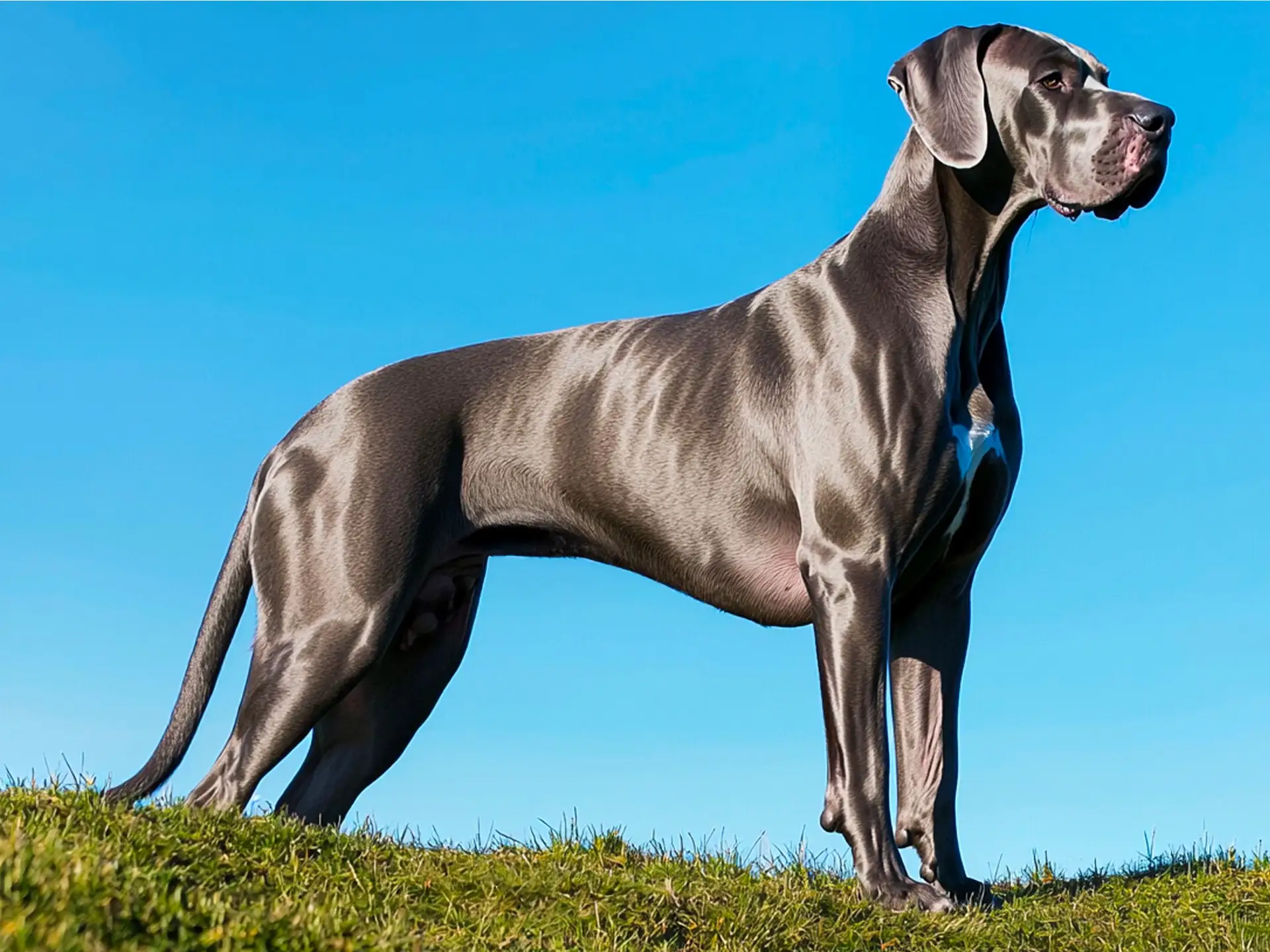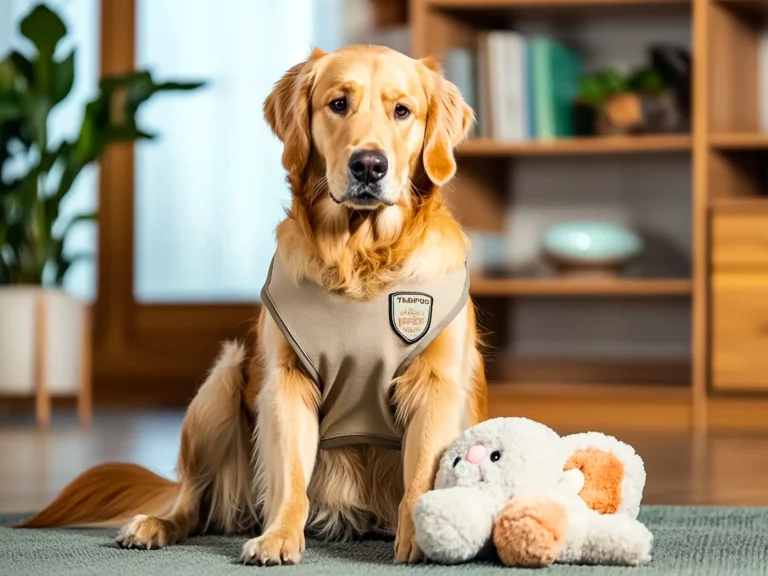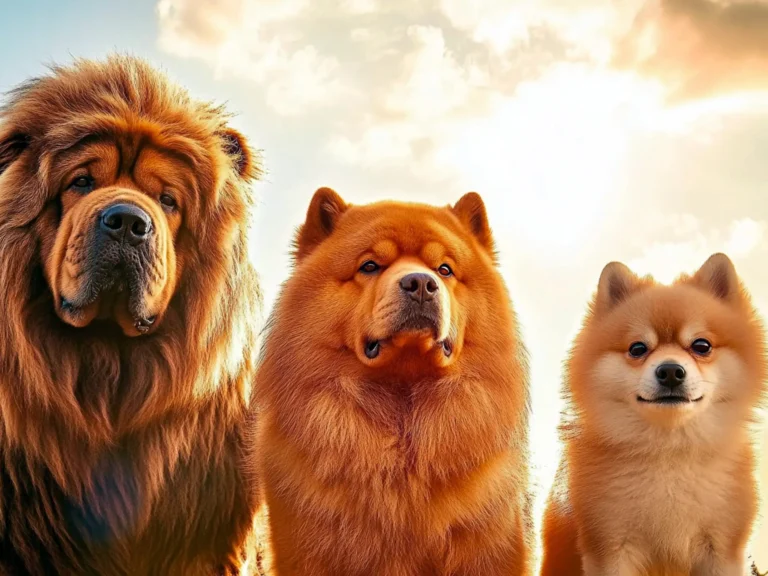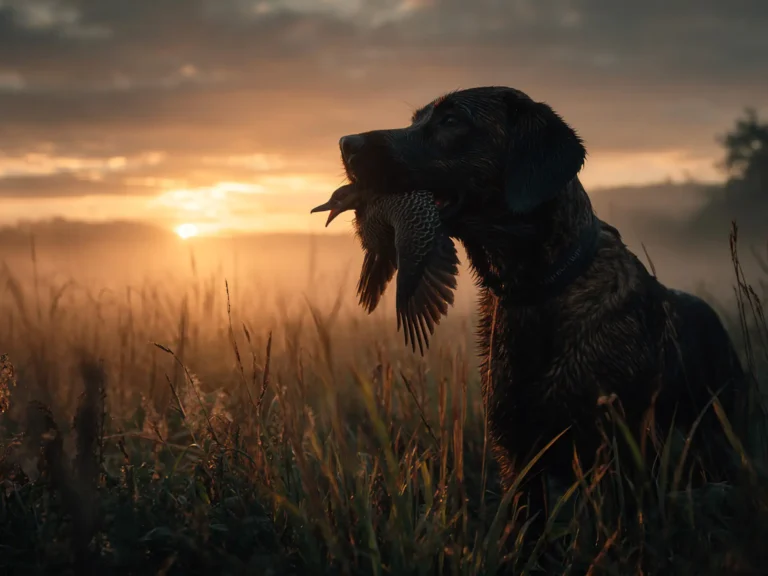Some dogs are built for speed, stamina, and strength — and one of the biggest giveaways is the shape of their chest. Deep chested dog breeds have a distinct body structure that sets them apart, influencing everything from athletic performance to certain health risks.
- What Makes a Dog "Deep Chested"?
- Physical Traits of Deep-Chested Breeds
- Deep-Chested Dogs vs Barrel-Chested Dogs
- Why Chest Shape Matters
- Common Health Risks in Deep-Chested Dogs
- Prevention and Care Tips for Deep-Chested Breeds
- Full List of Deep-Chested Dog Breeds (With Pictures)
- How to Tell if Your Dog Has a Deep Chest
- Most Non-Aggressive Deep-Chested Breeds
- Frequently Asked Questions About Deep-Chested Dogs
- Conclusion: Living with a Deep-Chested Dog
Whether you own one or are considering adding one to your family, this guide covers everything you need to know: what “deep chested” means, how it impacts your dog’s life, common breeds, health concerns, and care tips.
What Makes a Dog “Deep Chested”?
Have you ever watched a Greyhound fly across the field, with a ribcage that drops close to the elbows and a sleek, racing build, and wondered how structure powers performance? Those are deep chested dog breeds. This chest shape is more than a distinctive look. It is a functional advantage that affects breathing, stamina, and sometimes health.
What’s the real-world meaning of “deep chested”?
Veterinarians define a deep chest as one where the front of the rib cage extends below the elbows when the dog is standing square. This vertical elongation increases thoracic volume, which allows for larger lungs and a more powerful heart. These features are especially valuable for speed, endurance, and working ability.
Why Chest Depth Matters
A deep chest can provide
- Greater oxygen intake for better stamina
- More efficient cooling during intense activity
- Strong cardiovascular output for bursts of speed or sustained work
Greyhounds, for example, can sprint at up to 72 kilometers per hour thanks in part to this anatomy. However, the same structure increases the risk of gastric dilatation-volvulus (GDV), also called bloat, which is a life-threatening emergency
Comparison table: Deep chest vs average
| Trait | Deep-Chested Breeds | Average Chest Shape |
|---|---|---|
| Rib cage length | Extends below elbows | At or above elbow level |
| Shape from above | Oval or hourglass | Rounder or more rectangular |
| Functionality | High endurance, sprint capability | General-purpose, balanced movement |
| Health considerations | Elevated risk of bloat (GDV) | Lower risk |
Did you know?
- In a UK study of 77,088 dogs seen at emergency clinics, GDV (gastric dilatation-volvulus) had an overall prevalence of 0.64%, but certain deep-chested breeds—like Great Danes, Akitas, and Dogue de Bordeaux—had dramatically higher odds compared to cross-bred dogs. Source: Veterinary Record, 2017 (PubMed)
- Greyhounds, one of the most extreme deep-chested breeds, have a heart-to-body weight ratio averaging about 1.2–1.3%, compared to roughly 0.9% in typical domestic dogs — a difference linked to their athletic endurance (Schoning et al., 1995).
What to expect in this guide
By the end of this article you will understand:
- Exactly how deep chested anatomy affects performance and health
- How to tell if your dog truly has a deep chest
- Which breeds are classic examples, broken down by size
- The most important health risks and how to prevent them
- How to adapt feeding, exercise, and care routines to keep them thriving
We will cite trusted veterinary journals, breed club standards, and peer-reviewed studies, so you can trust the accuracy of each statement. Let’s dive in and meet the top per
Physical Traits of Deep-Chested Breeds
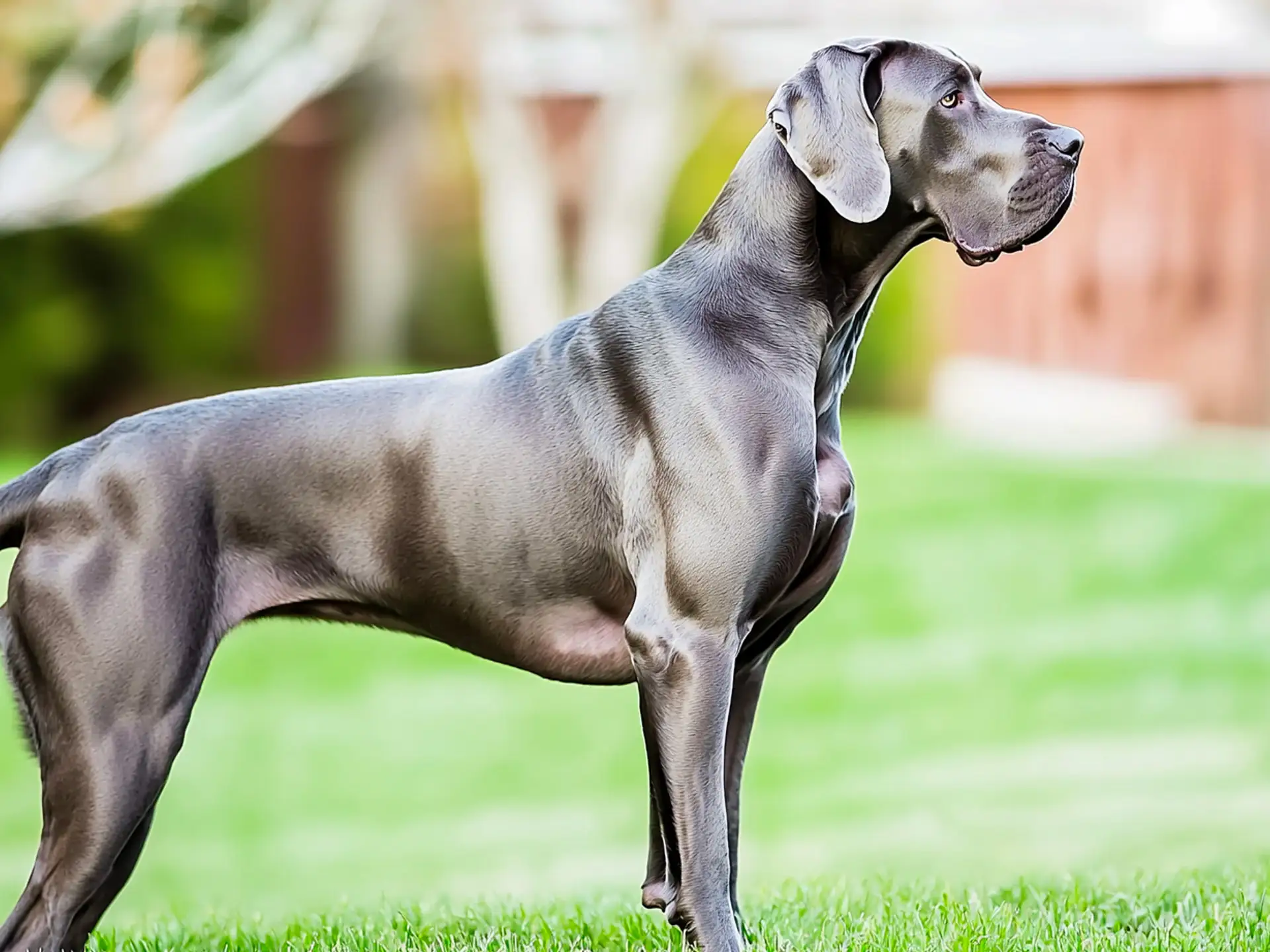
The chest of a deep-chested dog is not only visually distinctive but also mechanically different from other chest shapes. Understanding these physical characteristics will help you identify the trait, appreciate its advantages, and anticipate its care needs.
Ribcage Shape and Proportion
Deep-chested dogs have ribcages that extend further down toward the elbows, giving them a long vertical profile. The cross-section of the ribcage is typically oval rather than round, which creates a narrower but taller thoracic cavity. This shape allows for more lung capacity without adding unnecessary bulk.
Key identifiers:
- Ribcage extends at or slightly below the elbow joint
- Front of chest is well-defined and often prominent
- Viewed from above, the body narrows behind the ribs to form a noticeable waist
Posture and Gait Influence
Because the ribcage sits lower and is supported by a strong shoulder assembly, deep-chested dogs often display a fluid and extended gait. Their strides are long and energy-efficient. This makes them well-suited to tasks that require sustained movement, such as hunting over long distances, herding livestock, or running at high speeds.
Musculature and Athletic Ability
A deep chest is usually accompanied by powerful muscles in the shoulders, forelimbs, and core. These dogs are designed for both acceleration and endurance. Sighthounds use this advantage for short bursts of extreme speed, while working breeds use it for all-day stamina.
Visual Identification Guide
If you are unsure whether a dog is deep-chested, observe the following:
- Look from the side. The chest should appear deep and reach the level of the elbows or lower.
- Look from above. The chest should be more oval than circular.
- Feel along the ribcage. It should slope smoothly into a narrower waist.
This combination of form and function explains why so many of the world’s best athletes in the dog world share this build.formers of the canine world — shaped for speed, built for life, and cared for with precision.
Deep-Chested Dogs vs Barrel-Chested Dogs

Deep-chested and barrel-chested are terms that describe two very different ribcage shapes in dogs. While both can produce powerful athletes, their builds influence movement, breathing, and even common health concerns. Understanding the difference is important for breed identification, performance expectations, and preventive health care.
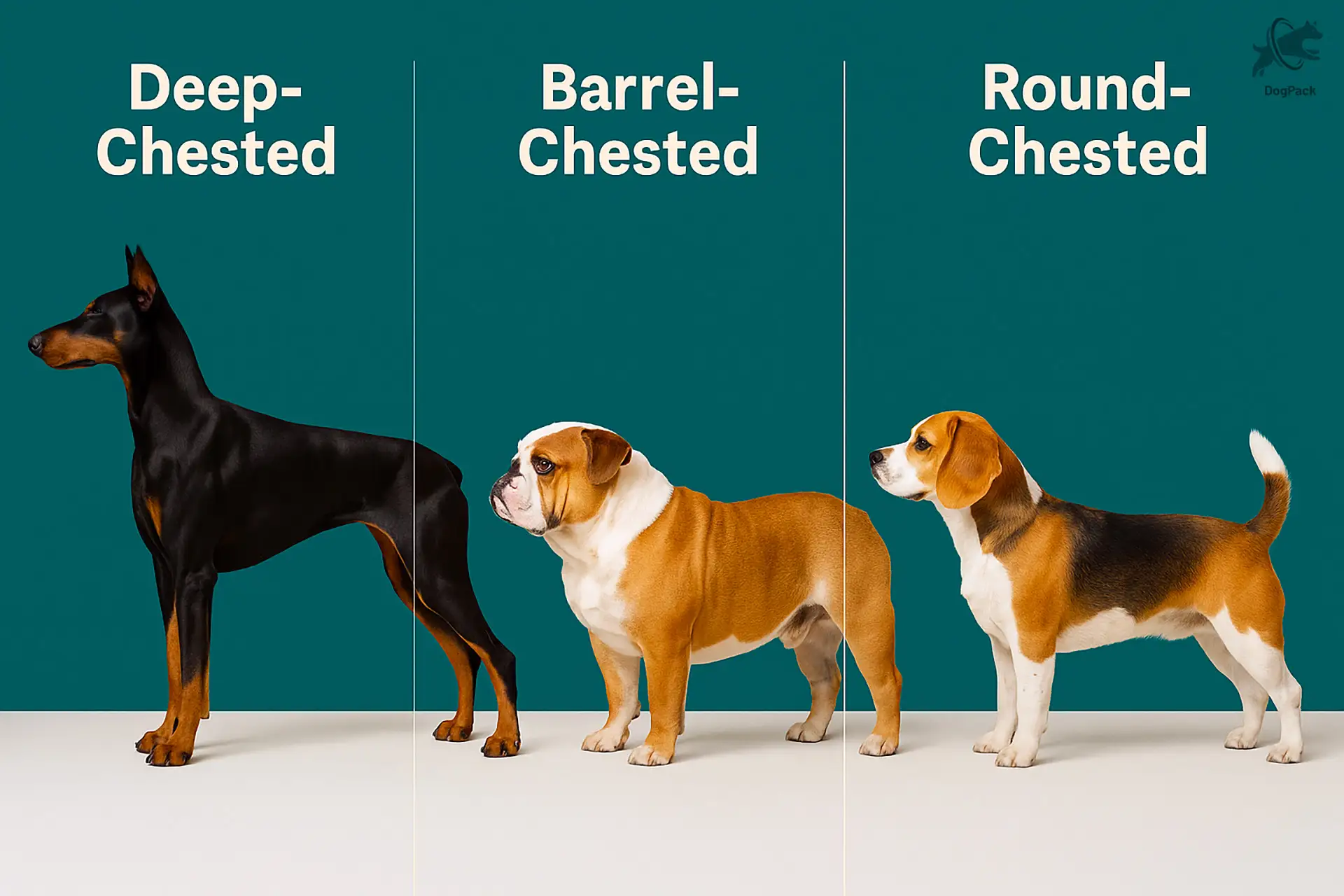
Core Differences
| Feature | Deep-Chested Dogs | Barrel-Chested Dogs | Round-Chested Dogs |
|---|---|---|---|
| Ribcage Shape | Tall and oval when viewed from the front | Broad and round from the front | More circular and uniform |
| Vertical Depth | Extends to or below the elbows | Level with or slightly above elbows | Similar to barrel, but shallower |
| Body Width | Narrower through chest and shoulders | Wider and more muscular | Moderate width |
| Performance Focus | Speed, stamina, agility | Power, stability, short bursts of strength | Balanced endurance and moderate speed |
| Common Health Concerns | Higher risk of gastric dilatation-volvulus (bloat) | Joint stress from heavier build | Lower risk of bloat, general joint issues |
How to Tell Which Type Your Dog Has
Stand your dog on level ground and check from the side first. If the chest drops noticeably toward or below the elbows and looks longer vertically than it is wide, it is likely a deep chest.
Then view the dog from above. If the ribcage appears narrower with a defined waist, it reinforces the deep-chested profile.
Barrel-chested dogs will appear broader from the front and top. Their ribcage forms a rounded shape, with less visible taper behind the ribs. This width provides a low center of gravity and stability, which is ideal for pulling, guarding, or bracing work.
Breed Examples
- Deep-Chested: Greyhound, Doberman Pinscher, Weimaraner, Belgian Malinois, Golden Retriever
- Barrel-Chested: Bulldog, Mastiff, American Staffordshire Terrier, Newfoundland
- Round-Chested: Beagle, Cocker Spaniel, Labrador Retriever
Why the Difference Matters
Deep chests are optimized for lung capacity and stride efficiency, while barrel chests are designed for raw strength and stability. Knowing your dog’s chest type helps you tailor exercise, training, and diet, and also alerts you to breed-specific health priorities.
Why Chest Shape Matters
The shape of a dog’s chest is more than an aesthetic detail. It influences movement, breathing, endurance, and overall health. In working, sporting, and companion dogs, chest depth can determine how well a dog performs specific tasks and how susceptible it might be to certain medical conditions.
Athletic Performance
A deep chest increases the available space for the lungs and heart. This extra capacity supports better oxygen exchange, allowing the dog to sustain activity for longer periods. Many sighthounds and hunting breeds rely on this anatomy to reach top speeds or to work all day in the field without tiring as quickly.
Working and Hunting Advantages
Dogs bred for herding, guarding, or pursuing prey often have deep chests to support the demands of their work. The additional lung capacity helps them recover faster between bursts of exertion. For example, a herding dog covering large distances benefits from the efficient stride and endurance that a deep chest supports.
Breathing Capacity and Stamina
The vertical ribcage shape allows the diaphragm and lungs to expand more fully. This means that deep-chested dogs can take in more air with each breath, making them more efficient during long-distance runs or high-intensity activities. This trait also helps them regulate body temperature through panting.
Health Implications
While advantageous for performance, a deep chest also comes with a higher risk of gastric dilatation-volvulus, commonly known as bloat. The extra depth allows the stomach more room to shift, which can lead to twisting under certain conditions. Awareness of this risk is critical for prevention and quick response. Large and giant deep-chested breeds can also face increased orthopedic strain, especially if they are overweight or overexercised at a young age.
Common Health Risks in Deep-Chested Dogs
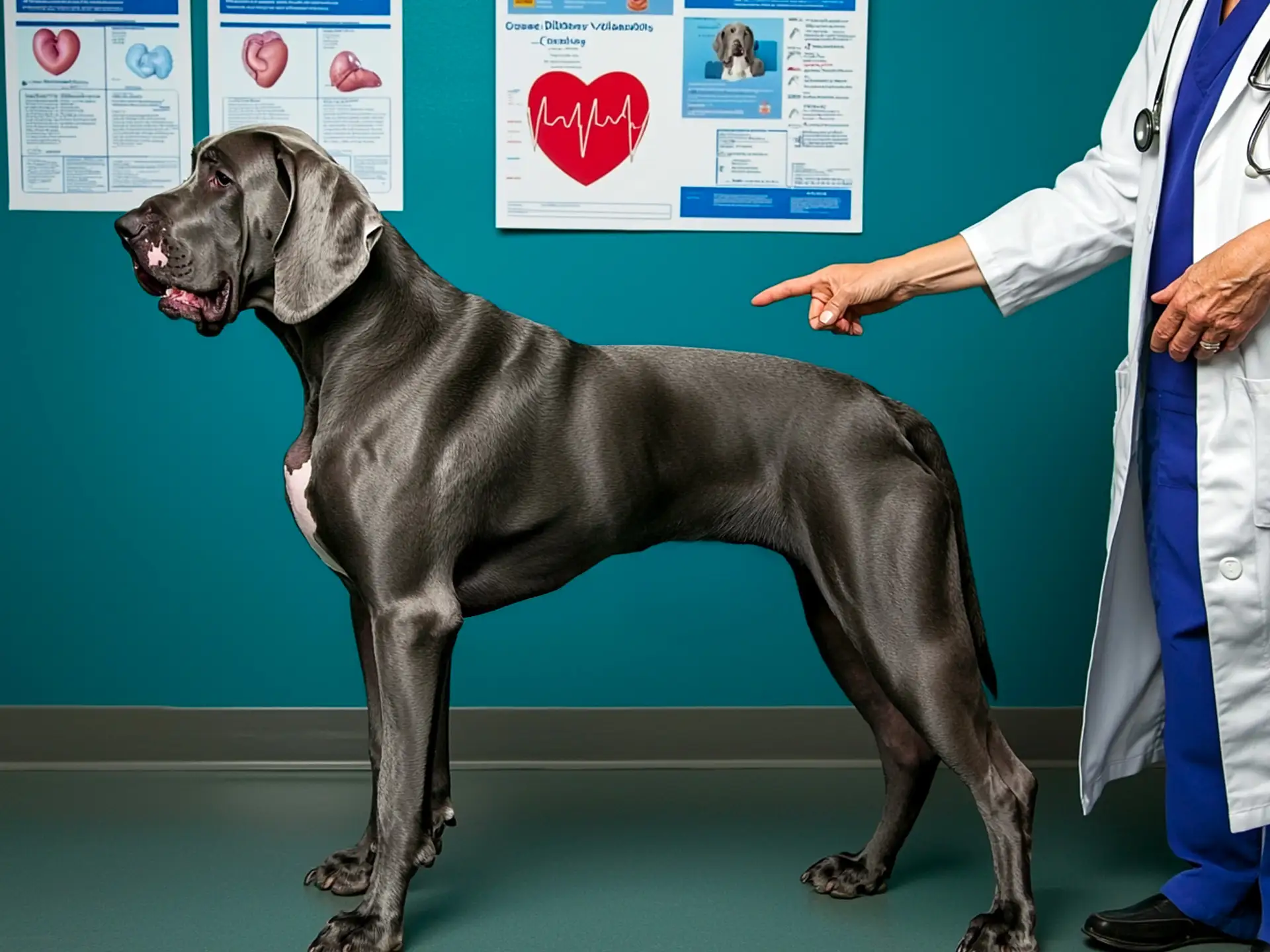
While the deep chest provides many advantages in performance and endurance, it also comes with some well-documented health vulnerabilities. Owners of deep-chested breeds should be aware of these risks and take preventive steps.
Gastric Dilatation-Volvulus (Bloat)
Bloat is the most serious and well-known health concern for deep-chested dogs. It occurs when the stomach fills with gas, food, or fluid, then twists on its axis. This twisting cuts off blood supply to vital organs and can be fatal if not treated quickly.
Large and giant deep-chested breeds like Great Danes face a lifetime GDV risk of up to 42%, according to a 2000 Purdue University study published in the Journal of the American Veterinary Medical Association (Glickman et al., JAVMA).
Why deep-chested dogs are at risk
The elongated ribcage and extra abdominal space can allow the stomach to move more freely. This mobility makes twisting more likely, especially after rapid eating, heavy drinking, or vigorous exercise soon after a meal.
Early signs to watch for
- Distended or hard abdomen
- Unproductive retching or attempts to vomit
- Restlessness and pacing
- Rapid breathing or excessive drooling
- Sudden weakness or collapse
Emergency action
Bloat is a veterinary emergency. Immediate treatment is the only way to save the dog’s life. Many veterinarians recommend discussing preventive gastropexy surgery for breeds at very high risk. Merck Veterinary Manual notes that preventive surgery can significantly reduce GDV incidence in predisposed dogs.
Orthopedic Problems
Some large deep-chested breeds are prone to joint and bone issues such as hip dysplasia, elbow dysplasia, and cruciate ligament injuries. These problems can be worsened by rapid growth in puppies, obesity, or excessive high-impact activity.
Preventive steps
- Maintain a healthy body weight
- Use controlled, age-appropriate exercise for puppies
- Avoid repetitive high-impact activities on hard surfaces
- Schedule regular orthopedic checks, especially for working or sporting dogs
Heart and Respiratory Issues
Although the deep chest allows for large lung capacity, certain breeds can be predisposed to heart conditions like dilated cardiomyopathy (DCM). Early detection through veterinary screenings can make management more effective.
Key takeaway: A deep chest does not automatically mean a dog will face these problems, but it does increase the likelihood. Awareness, preventive care, and fast action when warning signs appear can significantly improve a dog’s quality of life.
Prevention and Care Tips for Deep-Chested Breeds
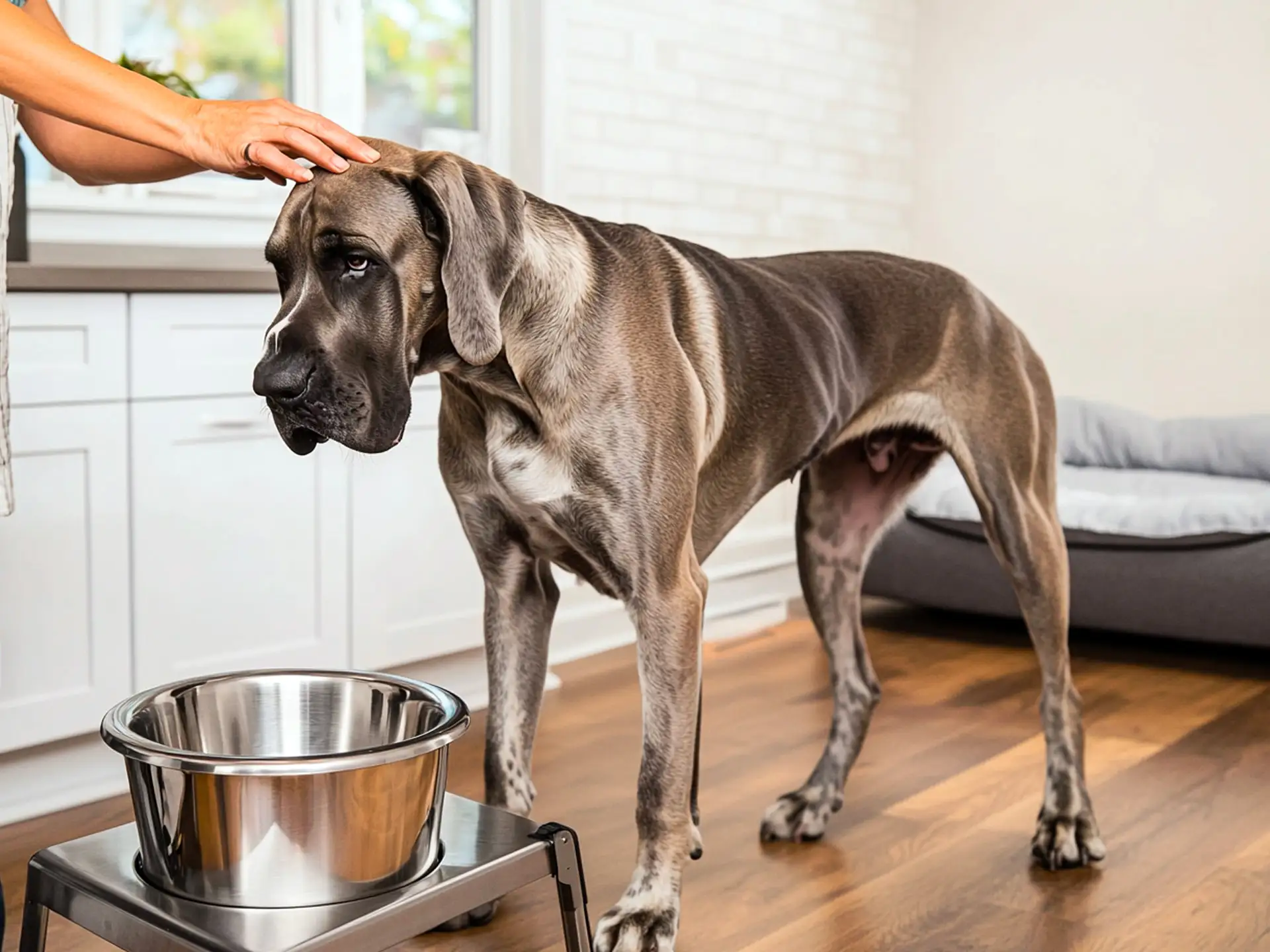
Owning a deep-chested dog means taking a few extra steps to protect their health, especially against conditions like bloat and orthopedic stress. With the right care, these dogs can live long, active, and healthy lives.
Feeding Routines
- Divide daily food into two or three smaller meals rather than one large meal.
- Use a slow feeder bowl for dogs that eat too quickly to reduce gulping of air.
- Avoid feeding immediately before or after vigorous exercise.
- Offer fresh water throughout the day but limit excessive drinking right before or after meals.
These habits reduce the chance of stomach distension, which is a known trigger for gastric dilatation-volvulus.
Exercise Timing and Intensity
- Wait at least one hour after eating before allowing intense exercise.
- Provide a mix of low- and moderate-impact activities to maintain fitness without overstressing joints.
- Keep high-speed running for appropriate breeds and only when fully warmed up.
Weight Management
Maintaining an ideal body condition score is essential. Excess weight adds stress to joints and increases the risk of many health problems.
- Monitor weight regularly and adjust food portions as needed.
- Use treats sparingly and account for them in daily calorie totals.
- Choose nutrient-rich diets formulated for your dog’s size, age, and activity level.
Veterinary Planning
- Ask your veterinarian if your dog’s breed is a candidate for preventive gastropexy during spay or neuter surgery.
- Schedule annual or bi-annual wellness exams that include heart and joint checks.
- Report any early signs of discomfort, stiffness, or digestive distress immediately.
Safe Environment
- Raise food and water bowls only if recommended by a veterinarian, as research is mixed on whether this affects bloat risk.
- Avoid prolonged exposure to extreme heat, as deep-chested dogs often have high activity drives and may overexert themselves.
- Provide non-slip flooring in the home to protect joints and prevent falls.
Full List of Deep-Chested Dog Breeds (With Pictures)
Deep-chested dog breeds are found in all size categories. Below is a complete list divided into large, medium, and small breeds. Each entry explains why the breed is deep-chested, what that means for performance or health, and one notable fact to help owners care for them.
Large Deep-Chested Breeds
Great Dane
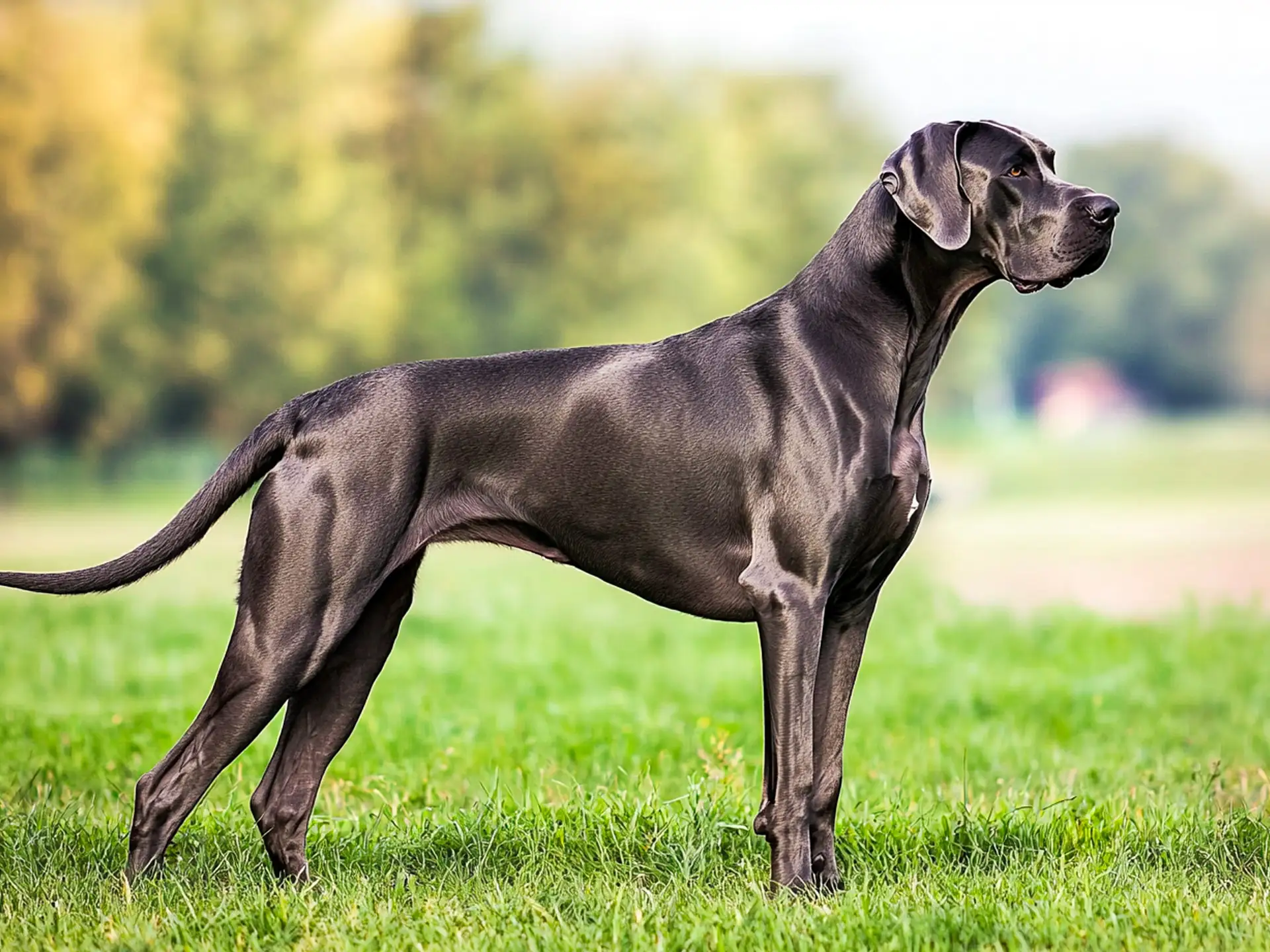
One of the tallest breeds in the world, with an extremely deep ribcage that extends well below the elbows. This supports a long, steady stride but also places the breed at one of the highest risks for bloat. Owners must be diligent about feeding routines and avoiding intense exercise after meals.
German Shepherd
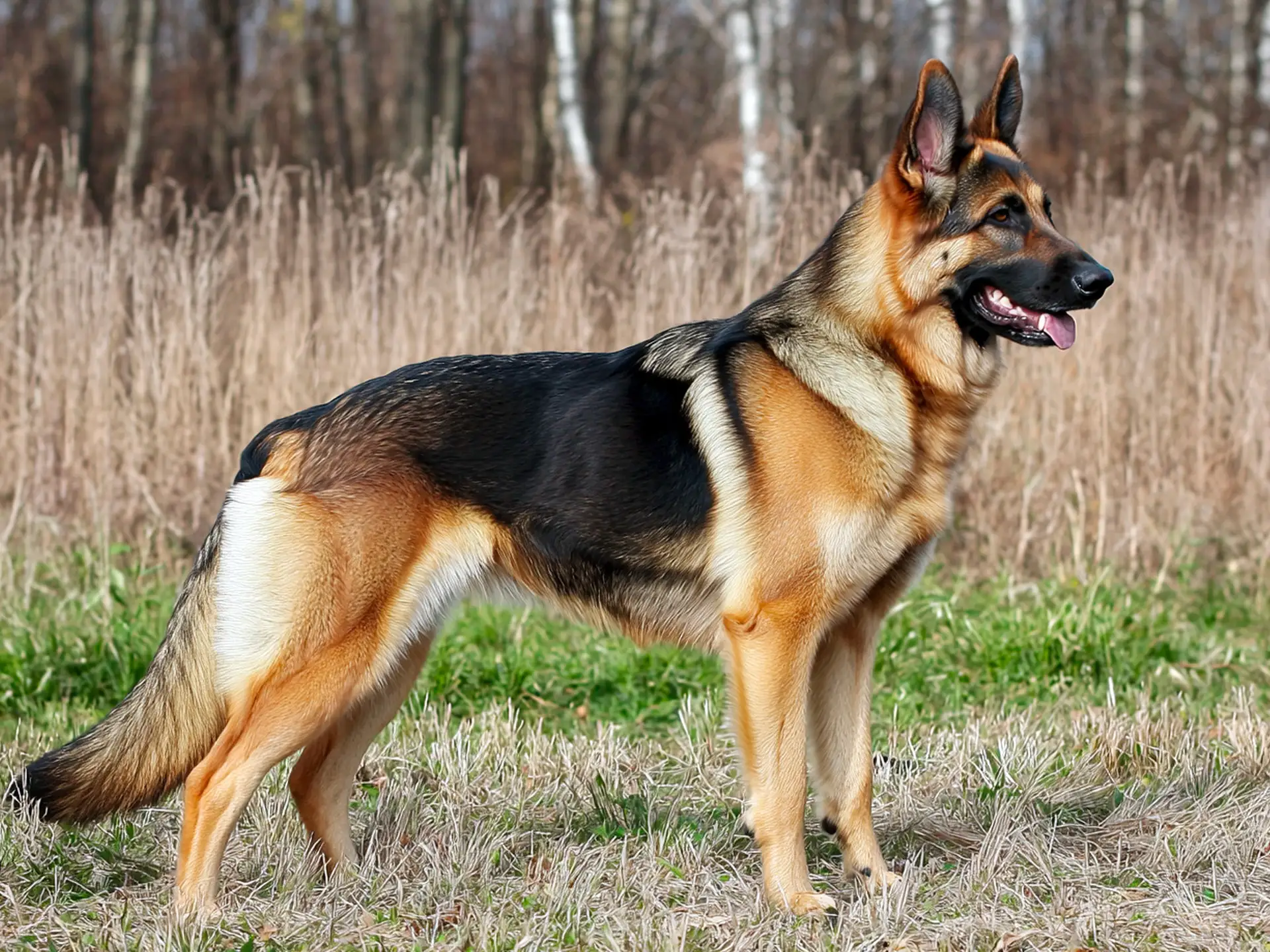
Known for its versatility in police, military, and herding work, the German Shepherd has a moderately deep, oval chest that enhances lung capacity and stamina. This build supports its ability to work for hours, but it also requires regular conditioning to avoid orthopedic strain.
Greyhound
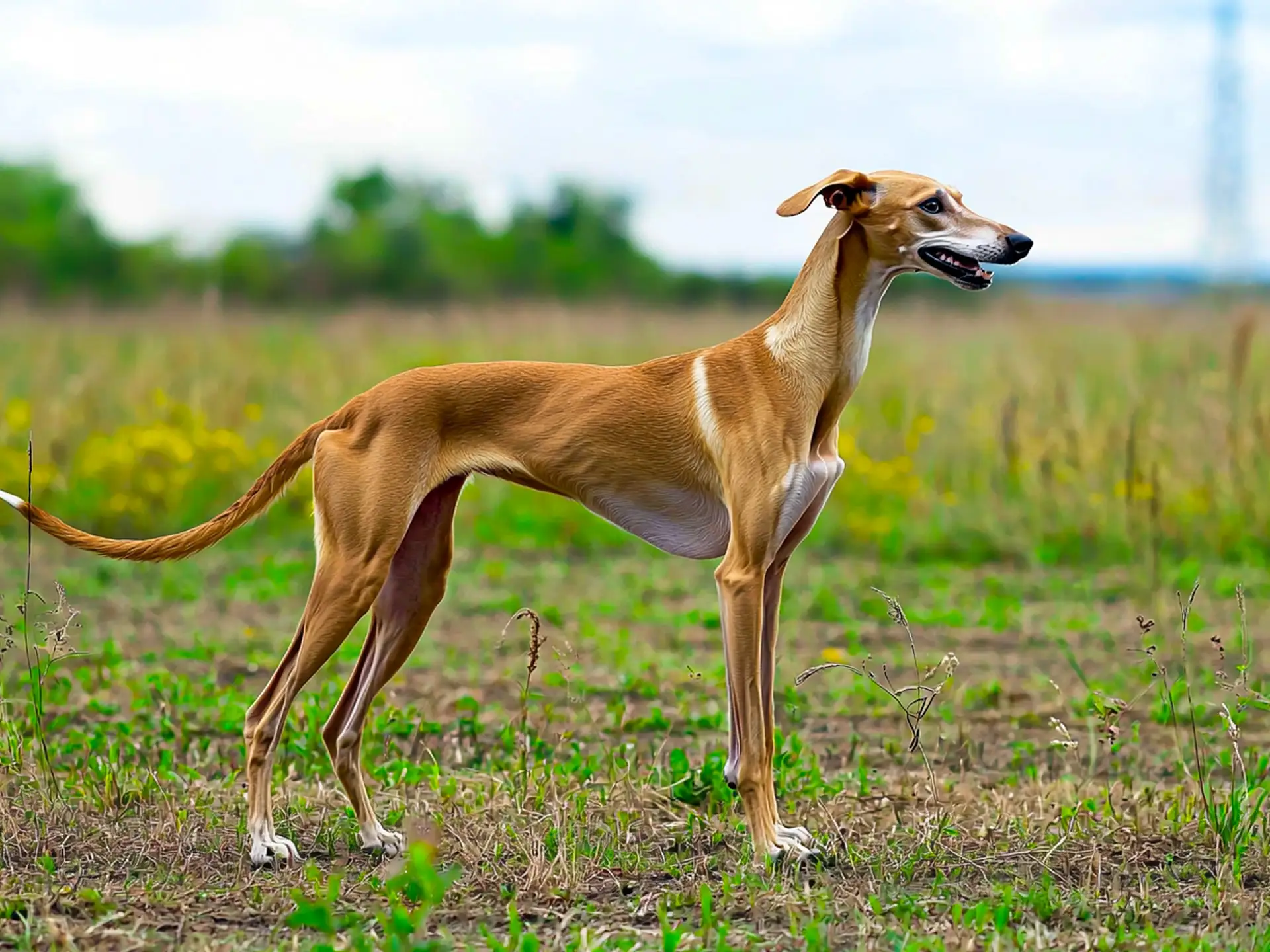
A textbook example of a deep chest, the Greyhound’s tall, narrow ribcage and tucked waist are built for sprinting up to 72 km/h. The extra lung volume and heart size make it one of the most efficient canine athletes.
Doberman Pinscher

Sleek and muscular with a pronounced oval chest, the Doberman’s build supports both speed and endurance. The breed’s energy demands regular activity to maintain peak condition and reduce stress-related health risks.
Rottweiler
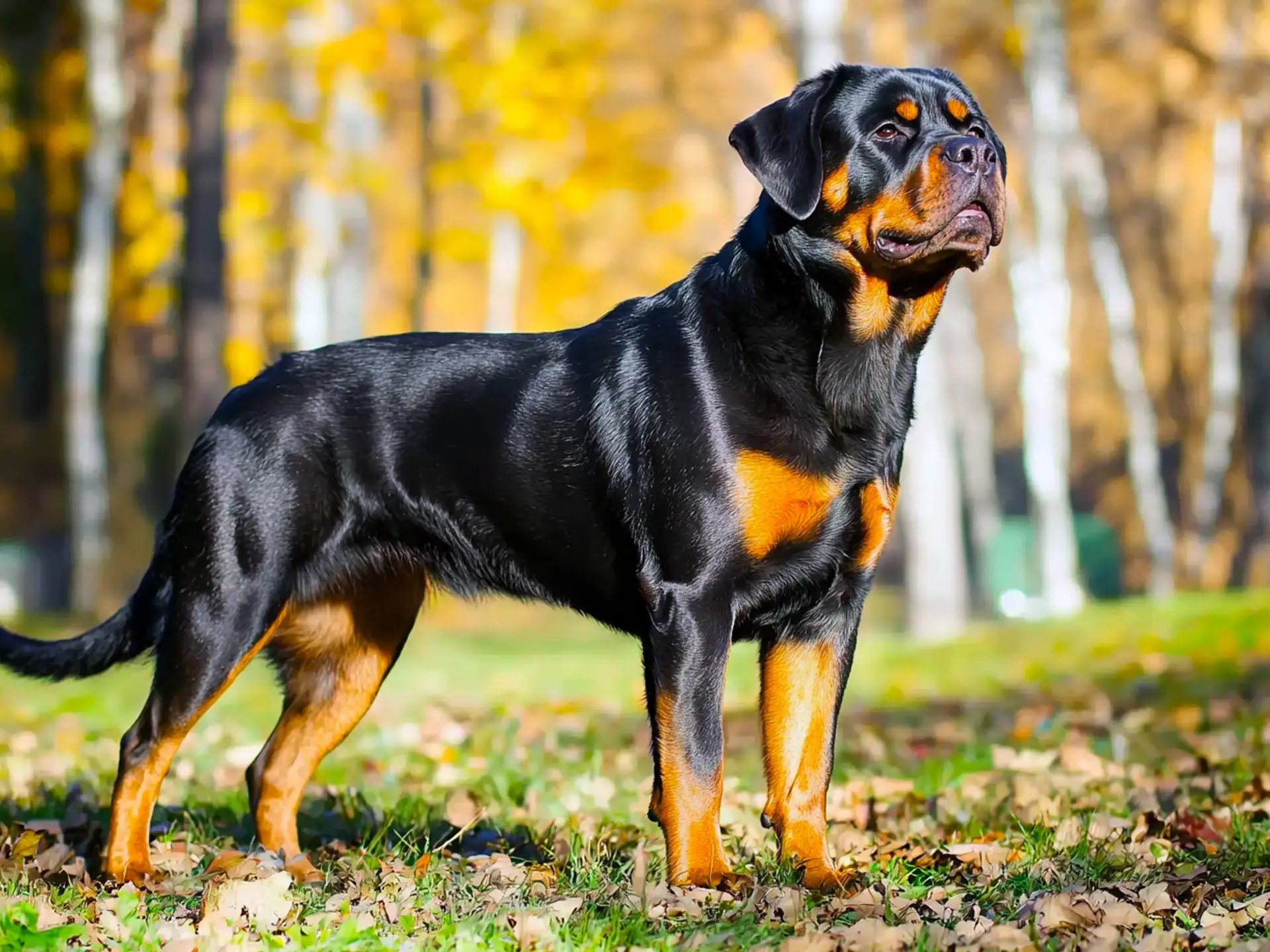
A powerful working dog with a deep and broad chest, giving it strong respiratory capacity for sustained work. This same anatomy increases the need for controlled feeding to reduce bloat risk.
Belgian Malinois
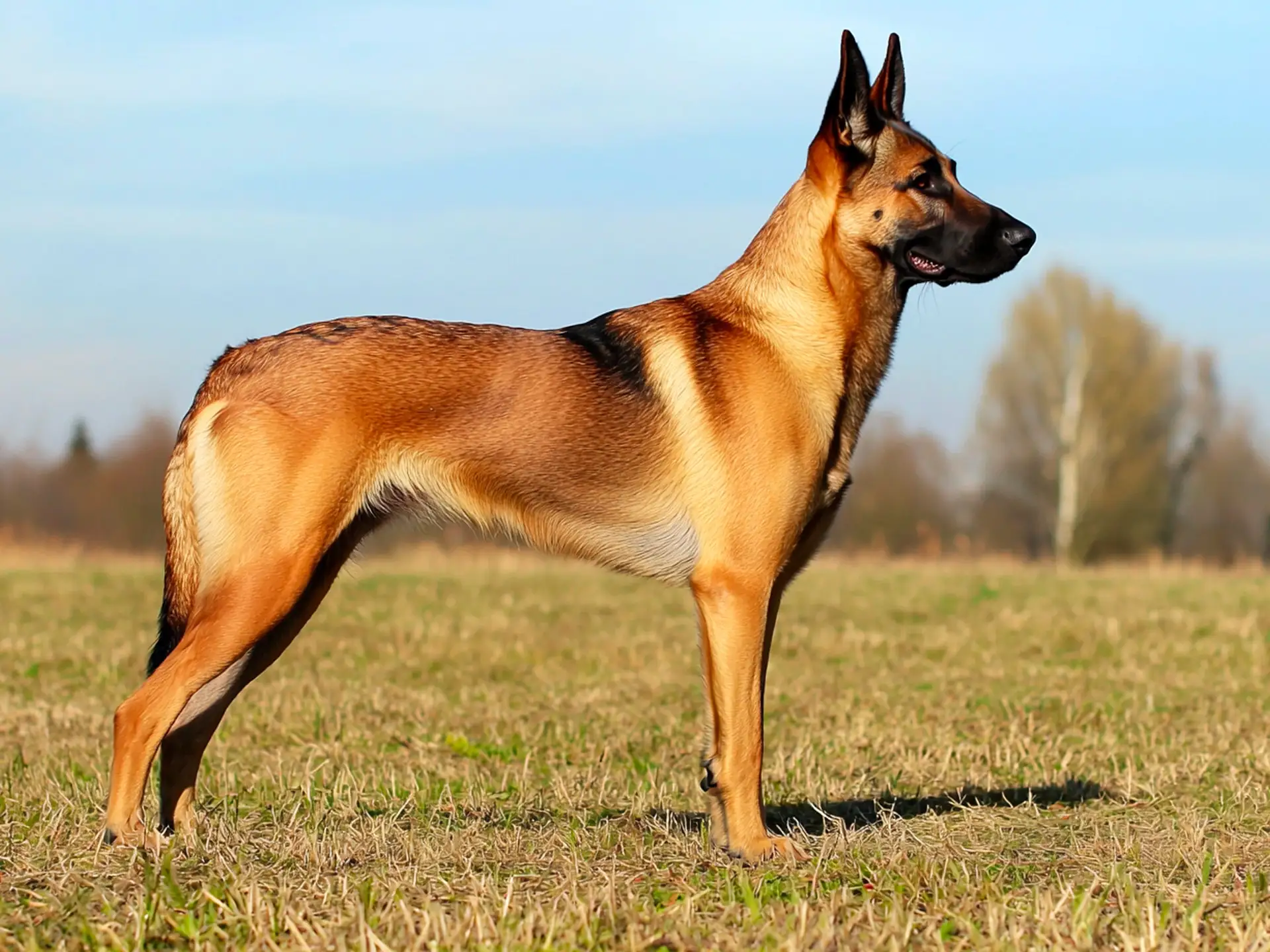
Athletic and driven, with a well-developed, deep ribcage that fuels its exceptional stamina. Requires daily high-intensity exercise and mental challenges to stay healthy and balanced.
Medium Deep-Chested Breeds
Border Collie
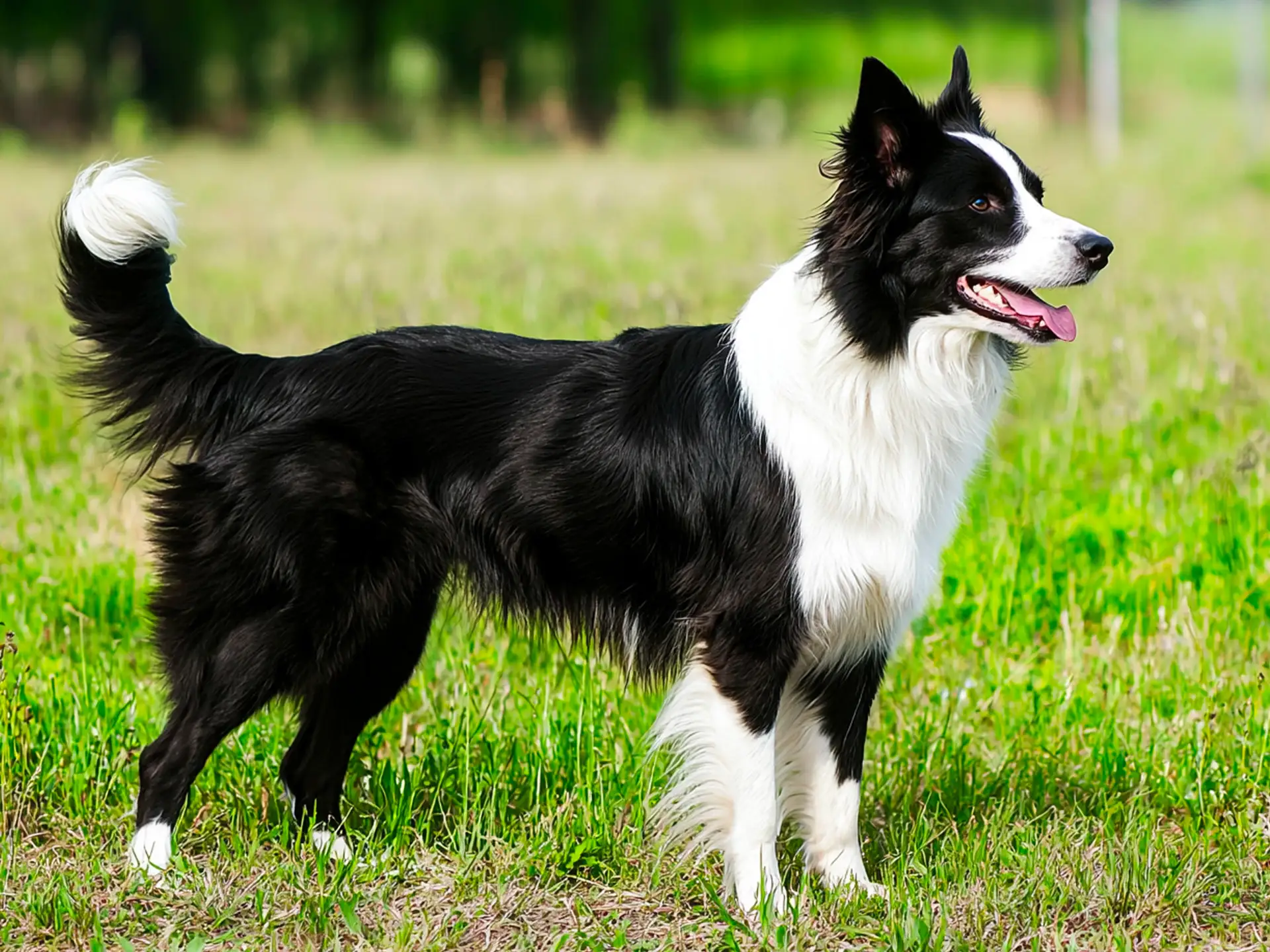
An agile herding dog with a deep chest that supports its ability to cover large distances without tiring. The build complements its unmatched intelligence and work ethic.
Weimaraner
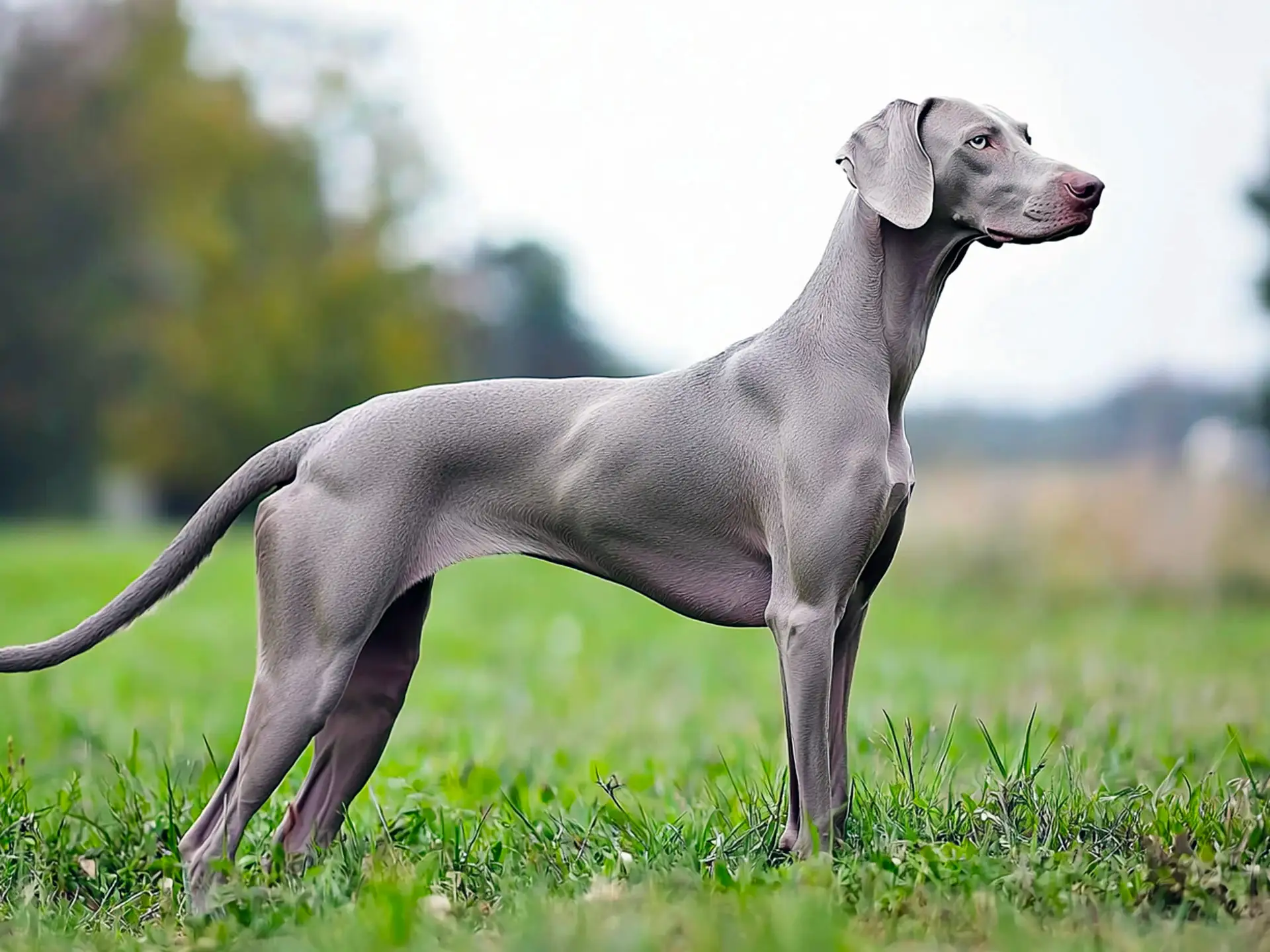
A hunting breed with a narrow, deep chest that supports long chases in the field. The Weimaraner benefits from regular exercise and structured mealtimes to reduce bloat risk.
Boxer
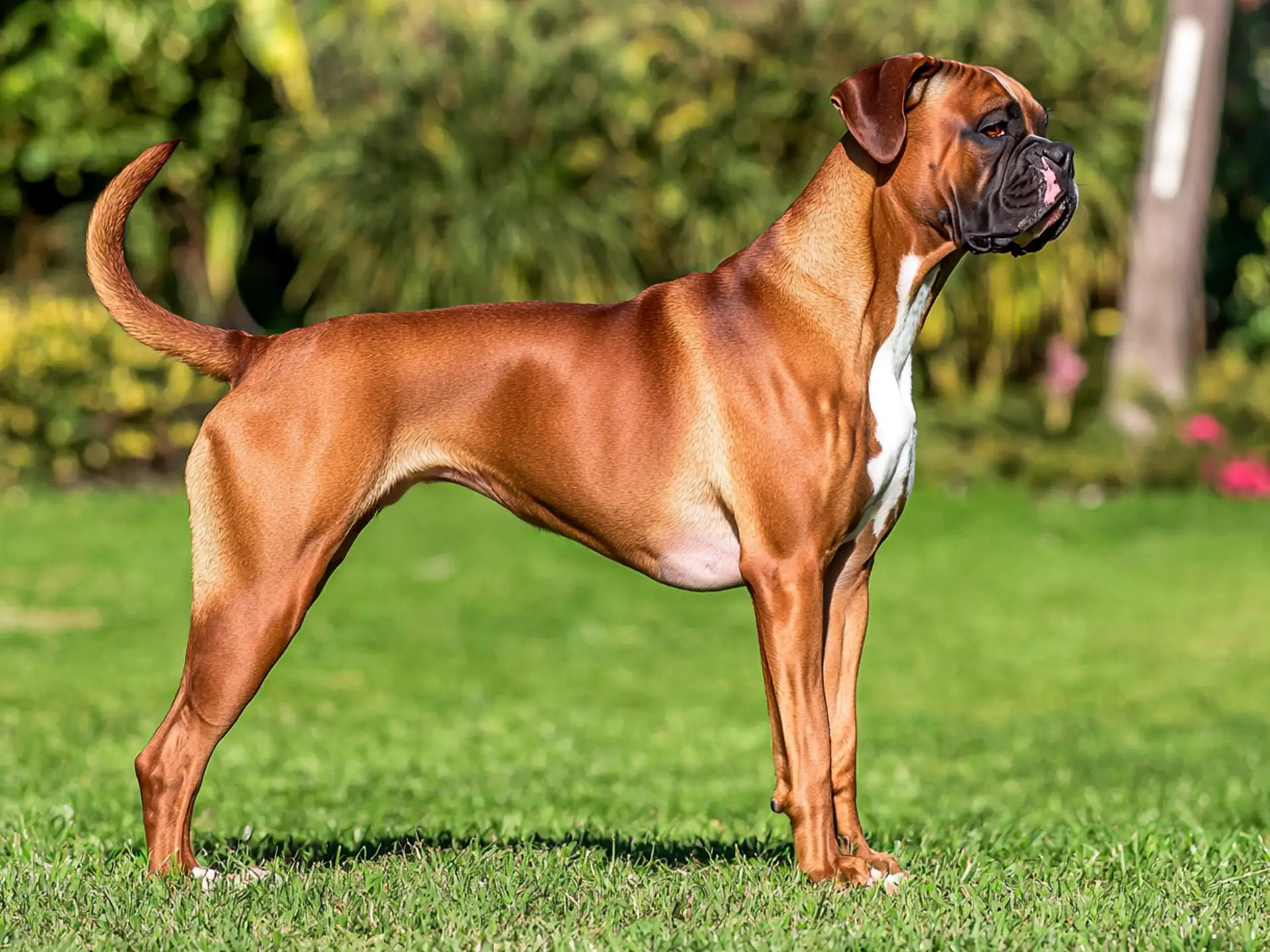
A playful guardian breed with a wide, deep ribcage. The chest aids in endurance, but owners should be aware of both bloat and certain cardiac conditions.
Vizsla
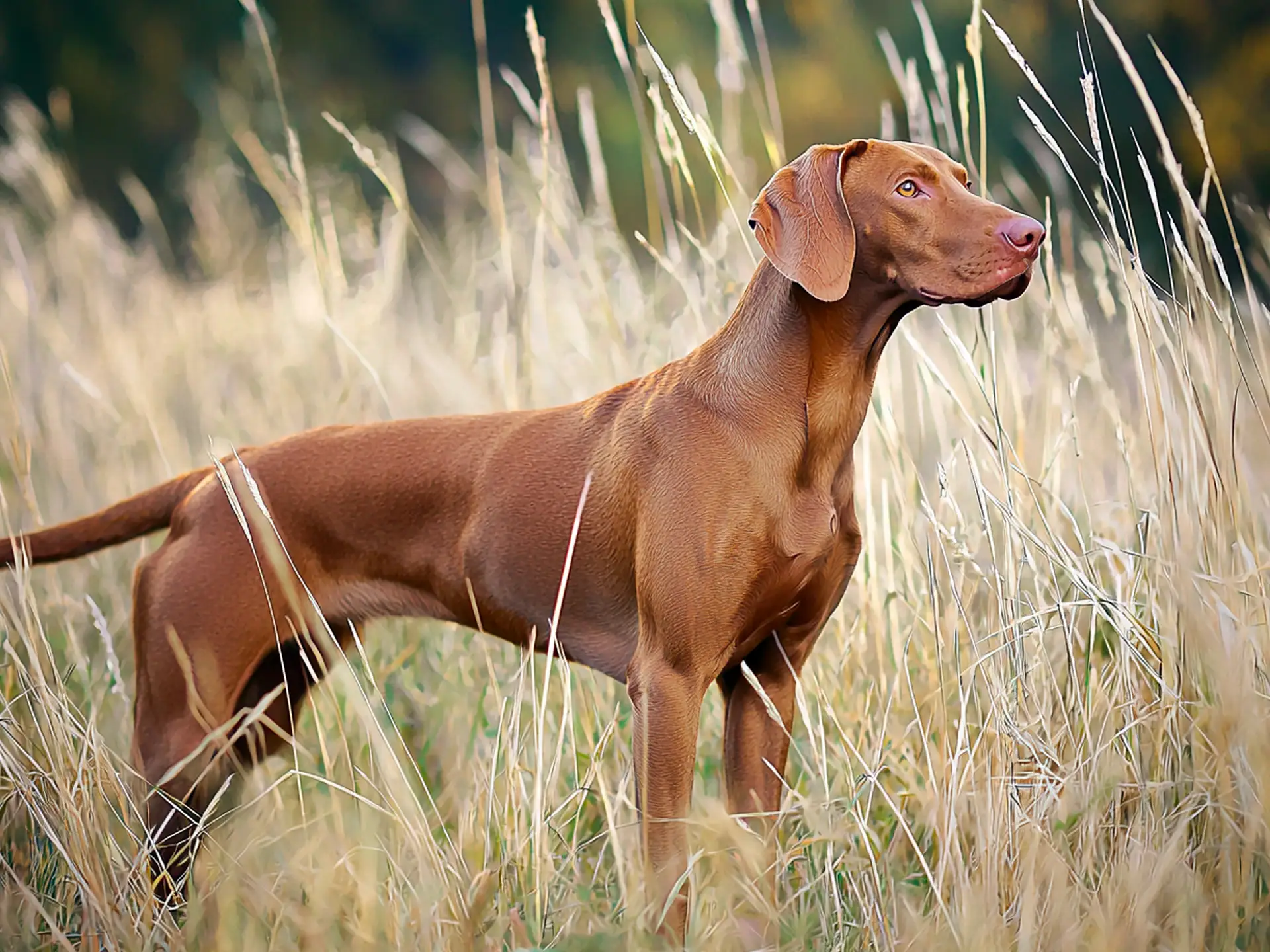
Lean and athletic with a defined deep chest, the Vizsla excels in both hunting and companionship. It thrives on human interaction and requires a balanced mix of exercise and rest.
Golden Retriever

Friendly and adaptable, with a moderately deep chest that supports strong swimming ability and endurance. Families should monitor feeding habits to avoid weight gain, which can stress the joints.
Goldendoodle
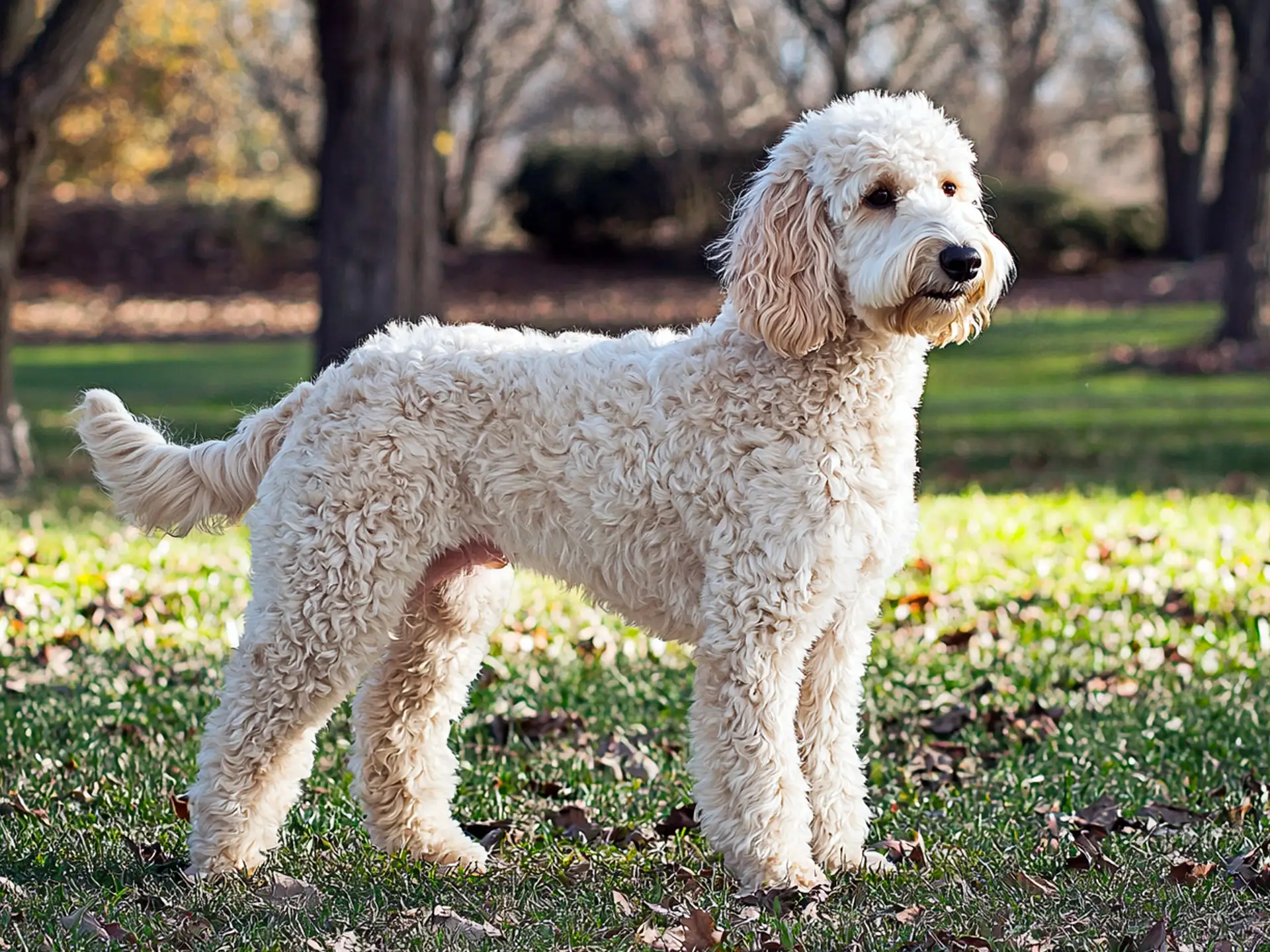
Chest depth varies depending on lineage, but many larger Goldendoodles inherit a moderately deep chest from their Poodle side, enhancing stamina. Active play and measured feeding are key for health.
Small Deep-Chested Breeds
Dachshund
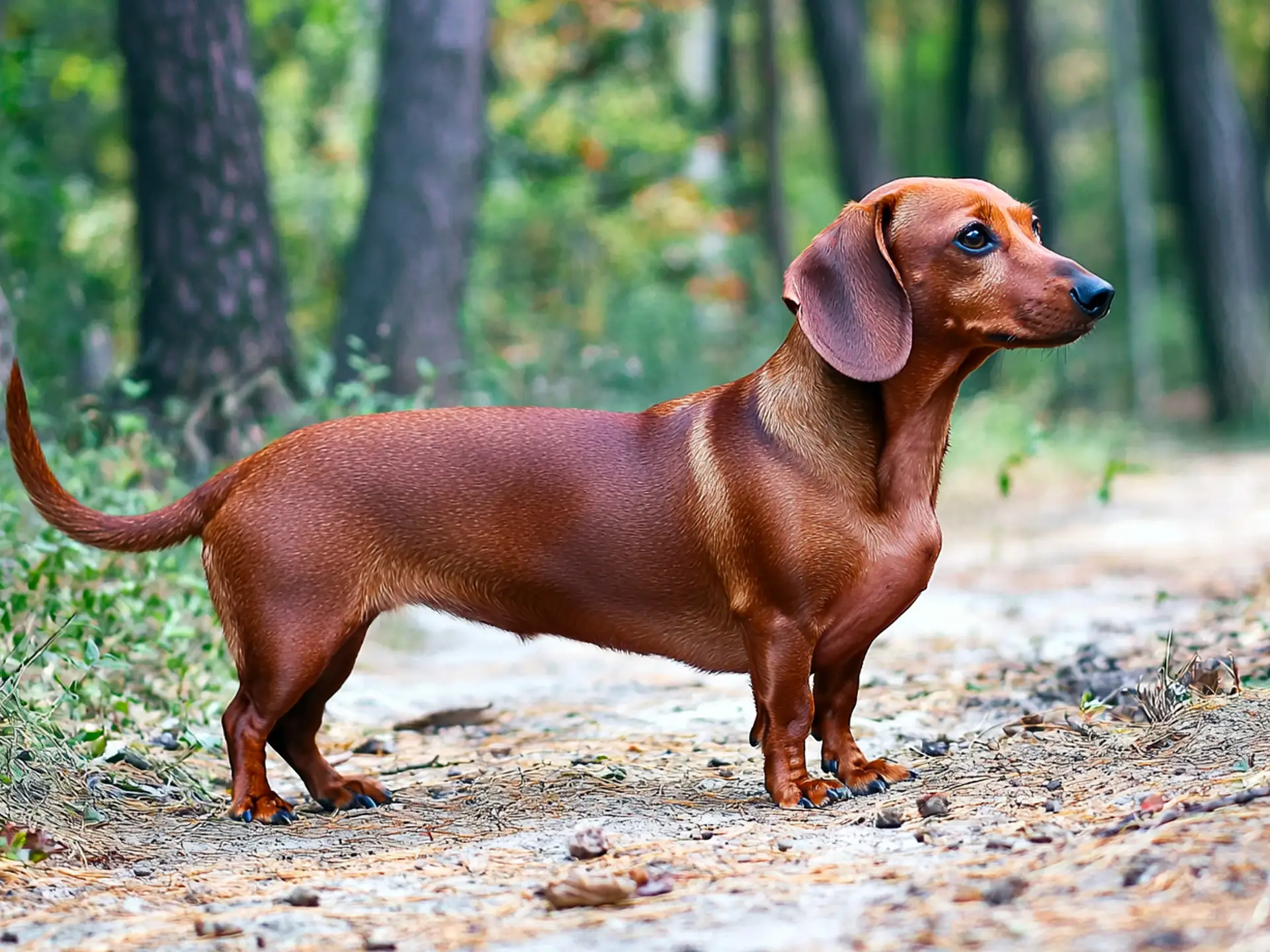
Small in stature but with a pronounced keel-shaped chest that reaches near the elbows. This shape aids in stamina for ground tracking but also contributes to a long spine, making weight management essential.
Whippet
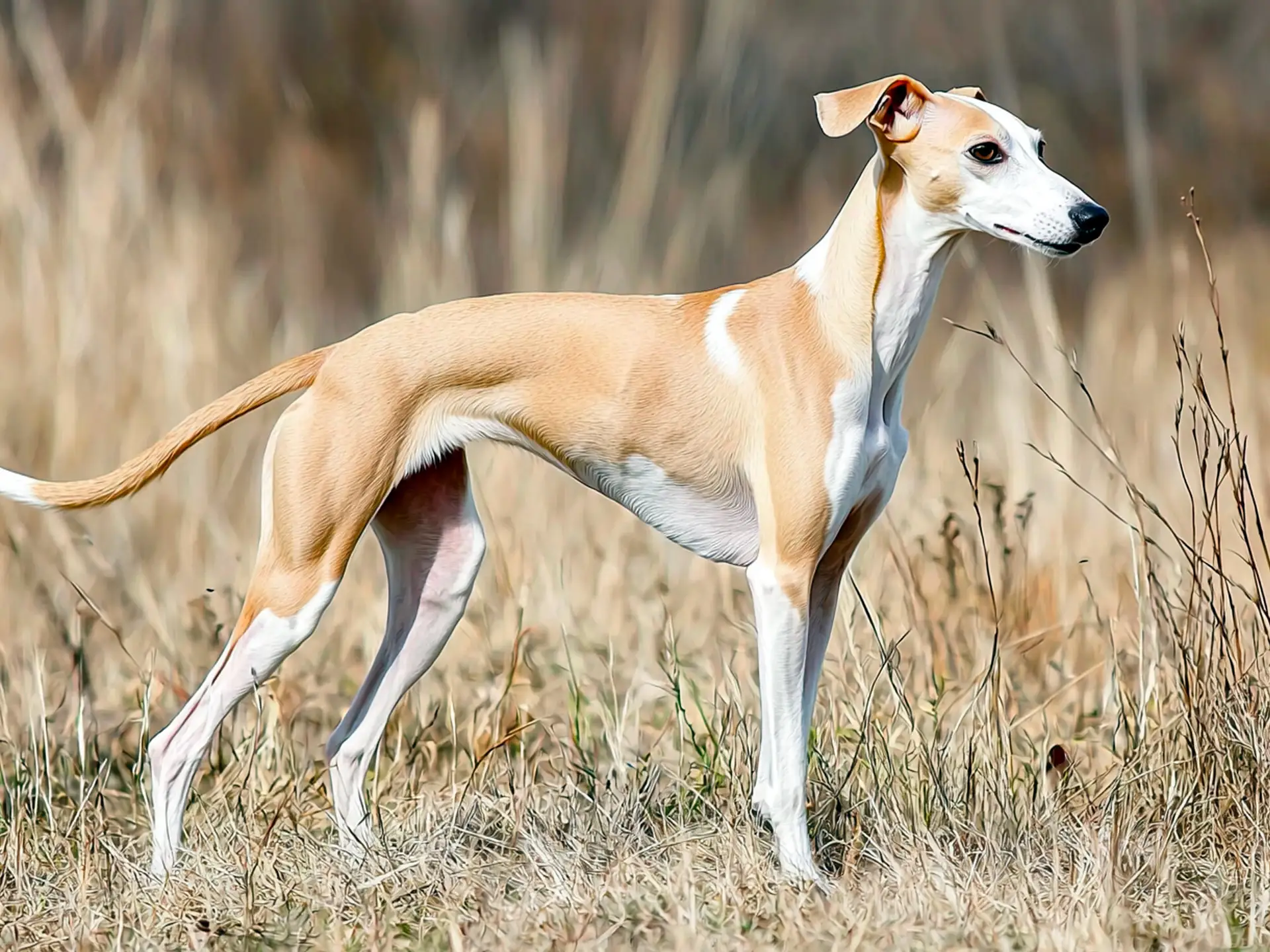
A miniature sprinter with a tall, narrow ribcage similar to the Greyhound. The Whippet’s deep chest powers its short bursts of high speed.
Jack Russell Terrier
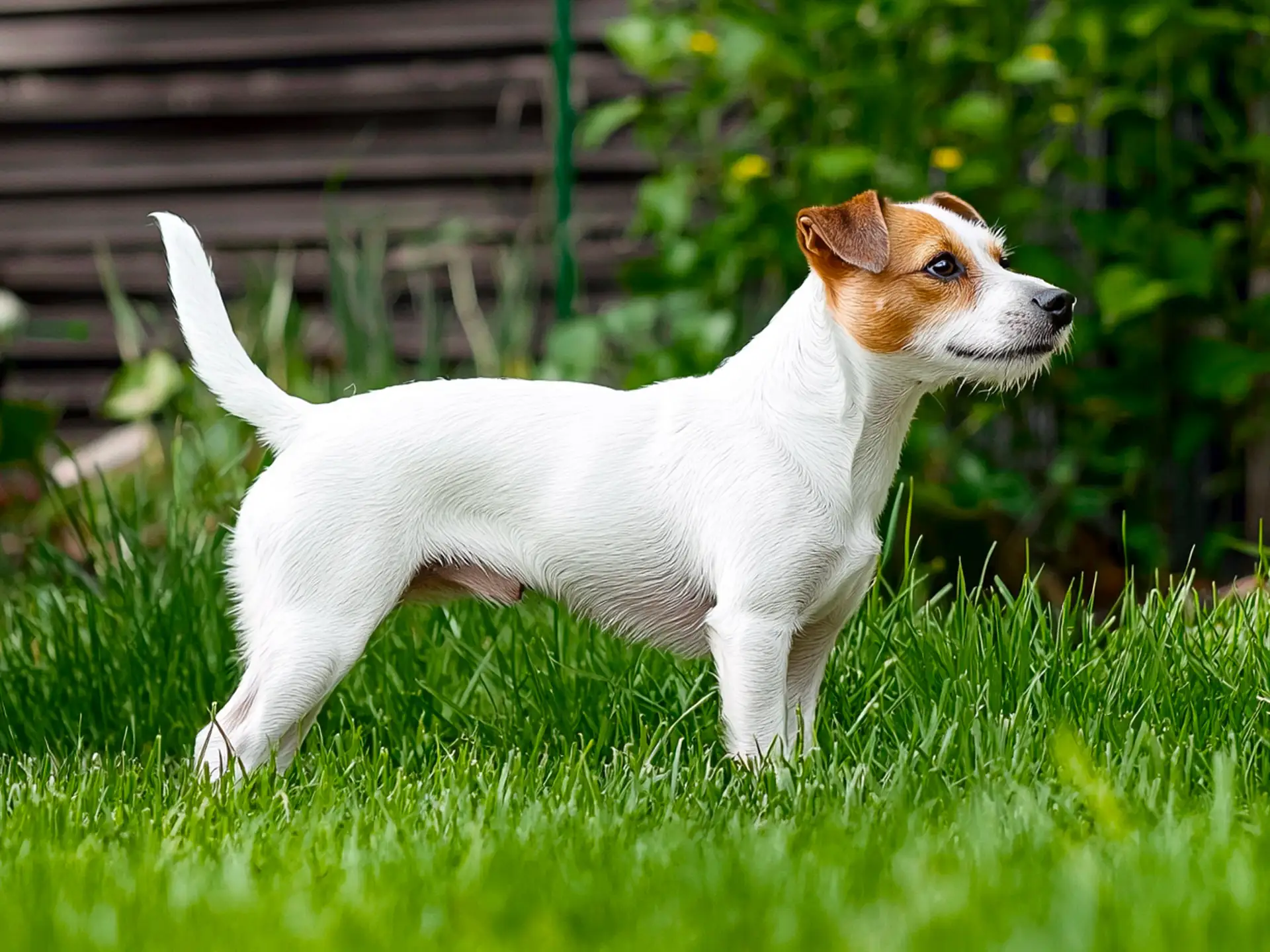
Compact and muscular with a chest that often reaches the elbows, built for digging and chasing quarry underground. Needs controlled, high-energy exercise to match its drive.
Italian Greyhound
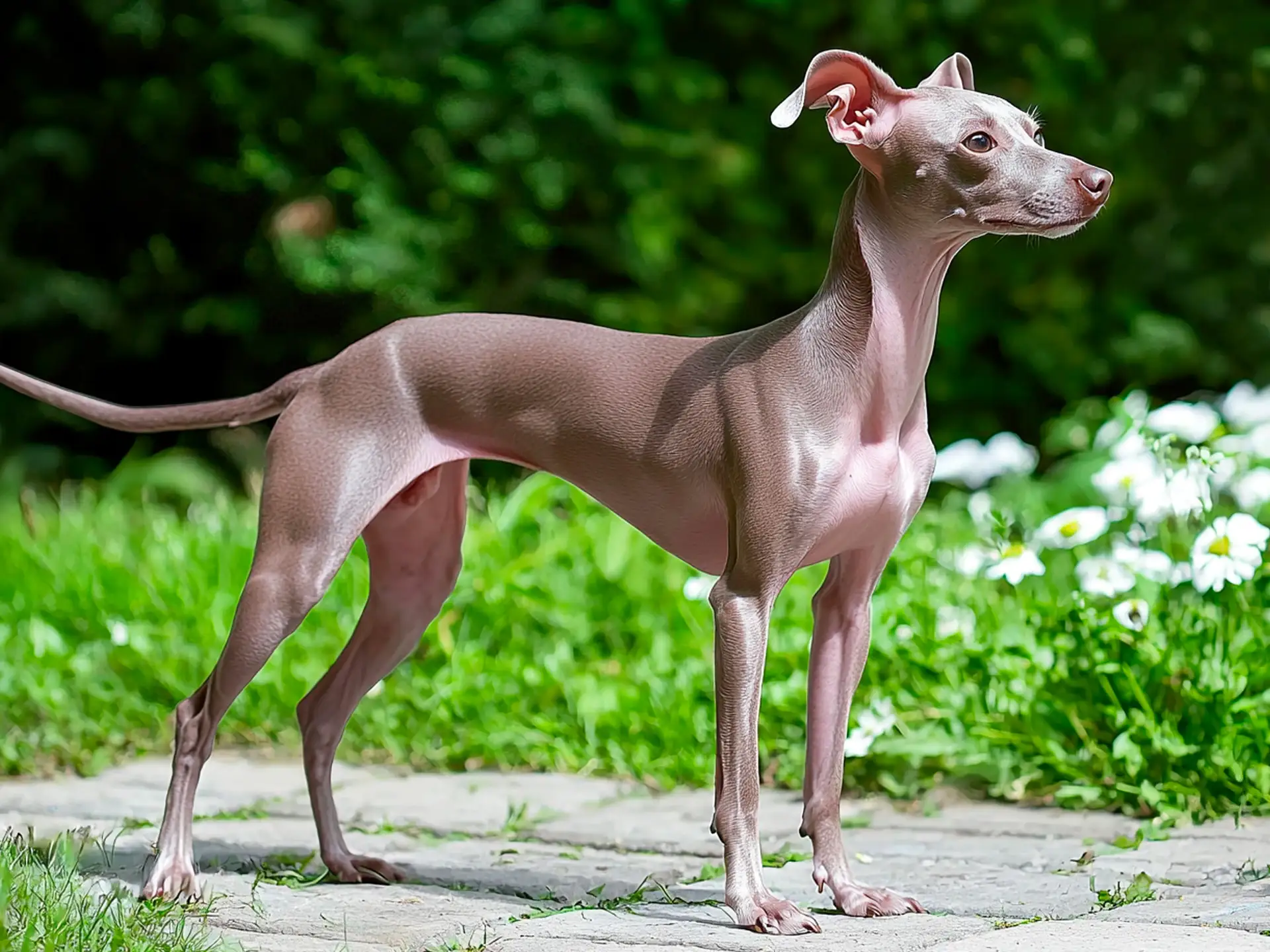
A fine-boned sighthound with a delicate but deep chest, giving it surprising speed for its size. This breed prefers short sprints and gentle handling.
Other Mentions Based on Common Questions
- Pit bull type dogs often have a wider, more barrel-shaped chest, although some individuals lean toward moderate depth.
- Huskies typically have a medium-depth chest suited for pulling and endurance work, not extreme sprinting.
| Breed | Chest shape | Size | Relative bloat risk | Helpful note |
|---|---|---|---|---|
| Great Dane | Very deep and tall ribcage | Large | Very high | Split meals and avoid intense exercise near mealtimes |
| German Shepherd | Moderately deep oval chest | Large | Elevated | Keep lean and condition joints with varied surfaces |
| Greyhound | Deep and narrow with defined tuck | Large | Moderate | Provide safe sprint outlets and warm recovery |
| Doberman Pinscher | Deep and athletic | Large | Elevated | Daily conditioning and calm cool down after meals |
| Rottweiler | Deep and broad front | Large | Elevated | Weight control and slow feeders for gulpers |
| Belgian Malinois | Deep working build | Large | Moderate | Structured high intensity work with rest days |
| Border Collie | Deep chest with light frame | Medium | Low to moderate | Long sessions of low impact cardio suit this breed |
| Weimaraner | Tall and narrow ribcage | Medium | High | Split meals and time activity away from feeding |
| Boxer | Deep and muscular | Medium | Moderate | Regular wellness checks and steady conditioning |
| Vizsla | Lean deep chest | Medium | Low to moderate | Daily exercise with calm rest after meals |
| Golden Retriever | Moderately deep chest | Medium | Moderate | Keep lean and watch portions to protect joints |
| Goldendoodle | Moderate to deep by lineage | Medium | Low to moderate | Activity needs vary by size. Use slow feeders if gulping |
| Dachshund | Deep keel near elbow level | Small | Low | Strict weight control to protect the back |
| Whippet | Deep and narrow | Small | Low to moderate | Short sprints and warm resting spaces |
| Jack Russell Terrier | Compact deep chest | Small | Low | Structured high energy play with steady cool downs |
| Italian Greyhound | Delicate deep chest | Small | Low | Gentle handling and short sprint outlets |
How to Tell if Your Dog Has a Deep Chest
Not every dog with a pronounced chest is truly “deep chested” in the veterinary sense. With a few quick observations, you can determine whether your dog’s chest falls into this category and understand what that means for their care.
Simple At-Home Check
Step 1 – Stand your dog naturally
Place your dog on a flat surface with their legs square under their body. Avoid having them sit or stretch forward.
Step 2 – Look from the side
A deep-chested dog’s ribcage will extend to the level of the elbows or slightly below. This creates a longer vertical distance from the back to the lowest point of the sternum.
Step 3 – Look from above
A true deep chest will appear oval in cross-section rather than round. Behind the ribs, you will notice a noticeable “tuck-up” at the waist where the abdomen narrows.
Step 4 – Feel for confirmation
Gently run your hand along the ribcage. In deep-chested dogs, you will feel a longer slope down toward the sternum before the ribs curve toward the abdomen.
Signs in Puppies vs. Adults
In many breeds, chest depth becomes more pronounced as the dog matures. Puppies often look a bit more rectangular in build until their ribcage develops fully, which can take up to two years in large and giant breeds.
When to Ask Your Vet
While the at-home test is helpful, your veterinarian can confirm chest depth during a routine exam. This is especially important if your dog is a breed known for bloat risk, as chest depth is one of the anatomical factors vets use to assess GDV risk.
Your vet may:
- Compare chest depth to breed standards
- Note any structural features affecting mobility or breathing
- Provide advice on diet, feeding schedule, and exercise routines suited for deep-chested anatomy
Why Knowing Matters
Recognizing whether your dog is deep chested is not just an exercise in breed identification. It influences health planning, exercise management, and awareness of risks like bloat. By understanding your dog’s structure, you can tailor their care to support a long, active, and healthy life.
Most Non-Aggressive Deep-Chested Breeds
Many deep-chested dogs were bred for work or sport, but several are also known for their gentle and even-tempered personalities. These breeds tend to be adaptable in family settings, good with children, and sociable with other pets when properly socialized.
Golden Retriever
One of the most popular family dogs in the world, the Golden Retriever has a moderately deep chest that supports stamina and strong swimming ability. Known for patience and friendliness, they thrive on companionship and regular activity. Their sociable nature makes them a reliable choice for households with children.
Labrador Retriever
Although not as extreme in chest depth as some sighthounds or giants, many Labradors have a moderately deep ribcage. They are famously friendly, eager to please, and adaptable to different lifestyles. Their gentle temperament, combined with solid endurance, makes them excellent for both active outings and relaxed family time.
Vizsla
The Vizsla’s lean, deep chest helps power its athletic ability, but it is also one of the most affectionate and people-oriented breeds. Known as “Velcro dogs,” they form close bonds with their families and are happiest when included in daily life. Their sweet nature pairs well with households that can provide both exercise and companionship.
Why Temperament Matters Alongside Structure
Choosing a dog based on temperament is just as important as considering health and structure. Deep-chested dogs with gentle personalities still benefit from the stamina and performance advantages of their build, but their easygoing nature makes them easier to integrate into homes with varied activity levels.
Frequently Asked Questions About Deep-Chested Dogs
How does a deep chest affect a dog’s ability to swim?
A deep chest can improve buoyancy and lung capacity, helping dogs swim longer without tiring. Breeds like Golden Retrievers use this advantage in water retrieval, though proper conditioning and safety supervision are still important for endurance and control.
Can deep-chested dogs compete in agility?
Yes. Many deep-chested breeds excel in agility thanks to their stride length and stamina. Training should focus on flexibility and core strength to prevent strain, as their build may require careful balance work on tight turns and elevated equipment.
Do deep-chested dogs need different harnesses?
Some do. A deep, narrow chest may make standard harnesses sit too high or restrict shoulder movement. Choosing an adjustable Y-front or ergonomic harness ensures better fit, reduces rubbing, and allows full range of motion during walks or training sessions.
Is a deep chest linked to faster running speed?
In many cases, yes. A deep chest increases lung and heart capacity, which supports sustained oxygen delivery during sprints. This is why sighthounds like Greyhounds and Whippets, with tall ribcages and slim waists, are among the fastest canine breeds.
Are deep-chested dogs more sensitive to heat?
Some high-performance deep-chested breeds can overheat quickly because they generate more body heat during exercise. Owners should monitor activity in hot weather, provide frequent rest breaks, and ensure access to shade and fresh water during outdoor activity.
Conclusion: Living with a Deep-Chested Dog
Owning a deep-chested dog means embracing both their impressive capabilities and their unique care needs. Their build gives them advantages in stamina, stride efficiency, and sometimes swimming ability, but it also calls for awareness of health risks such as gastric dilatation-volvulus.
The key to a long, happy life for these dogs is balance. Provide structured exercise to match their athletic potential, maintain a healthy weight, and use thoughtful feeding routines to minimize bloat risk. Keep up with regular veterinary checkups and be ready to adapt care as your dog ages.
By understanding the connection between your dog’s chest shape and their overall well-being, you can make better decisions about training, activity, diet, and preventive health care. Whether you live with a sprinting Greyhound, a loyal German Shepherd, or a playful Vizsla, your attention to these details will help them thrive.
Join the DogPack community to share stories, tips, and photos of your deep-chested dog. Connect with other owners, discover breed-specific advice, and explore dog-friendly locations near you. Your insights could help another owner keep their canine athlete healthy and happy.

